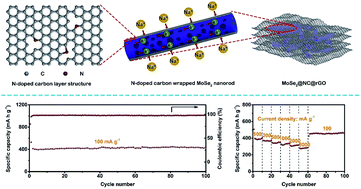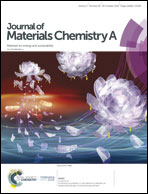Binding MoSe2 with dual protection carbon for high-performance sodium storage†
Abstract
Molybdenum selenide (MoSe2), a promising anode material for sodium ion batteries (SIBs), has generated intensive scientific interest due to its high theoretical capacity and favorable conversion kinetics. Nevertheless, its practical applications are seriously restricted by the volume variation, inferior structural stability and dissolved poly-selenides. Herein, we report dual carbon protected MoSe2 (MoSe2@NC@rGO) and the intrinsic mechanism for its enhanced sodium storage performance. Organic–inorganic hybrid Mo3O10(C2H10N2) (MoOx-EDA) is used as a self-sacrificing precursor. The synthesis process involves self-assembly of MoOx-EDA with functionalized graphene oxide (GO) and subsequent thermal selenization. The dual protection carbon layers can block the poly-selenide shuttling, promote electron transfer and buffer the huge volume change. When evaluated as an anode material for SIBs, the optimized MoSe2@NC@rGO-200 electrode delivers a high reversible specific capacity of 447 mA h g−1 at 100 mA g−1 and maintains an appreciable capacity of 281 mA h g−1 at 5 A g−1. Moreover, a capacity of 360 mA h g−1 is retained after 200 cycles at 1 A g−1 with no obvious capacity decay. A full-battery configuration coupled with the Na3V2(PO4)2/C cathode exhibits an average operating potential of 1.8 V and good cycling performance. Such a dual carbon-confined approach can also be extended to other electrode materials with large volume swelling.



 Please wait while we load your content...
Please wait while we load your content...